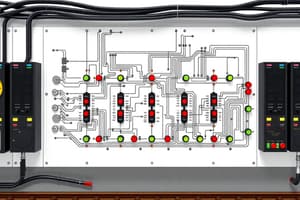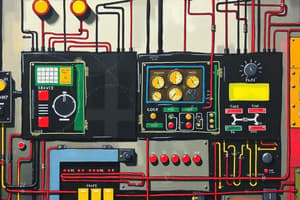Podcast
Questions and Answers
What color light indicates that a stop signal is 'ON'?
What color light indicates that a stop signal is 'ON'?
- Red (correct)
- Green
- White
- Yellow
Which of the following statements about the indication of a signal 'OFF' is true?
Which of the following statements about the indication of a signal 'OFF' is true?
- It is indicated only by a white light.
- It is never indicated by a flashing light.
- It can be indicated by a combination of green, yellow, or double yellow lights. (correct)
- It is always indicated by a red light.
Which indication is shown when there is a failure of the green light for a signal 'OFF' aspect?
Which indication is shown when there is a failure of the green light for a signal 'OFF' aspect?
- Both green and red flash
- Red flashes with no green
- Green not lit and red flashing
- Green flashes red (correct)
Which light indicates the 'ON' aspect of a shunt signal on an independent post?
Which light indicates the 'ON' aspect of a shunt signal on an independent post?
What is the indication for the 'OFF' aspect of a shunt signal located on the same post as a running signal?
What is the indication for the 'OFF' aspect of a shunt signal located on the same post as a running signal?
How is a 'Calling on' signal indicated when it is 'OFF'?
How is a 'Calling on' signal indicated when it is 'OFF'?
When should the starter indicator be lit according to the provided guidelines?
When should the starter indicator be lit according to the provided guidelines?
What action is indicated by a failure of the yellow light for a signal 'OFF' aspect?
What action is indicated by a failure of the yellow light for a signal 'OFF' aspect?
What principle should the route setting installations follow?
What principle should the route setting installations follow?
How many push buttons are required for controlling each route in installations of Route Setting type?
How many push buttons are required for controlling each route in installations of Route Setting type?
In the Non-route setting type installations, what is necessary to clear a signal after route setting?
In the Non-route setting type installations, what is necessary to clear a signal after route setting?
What feature is provided for documenting individual operations of points during failures?
What feature is provided for documenting individual operations of points during failures?
Which switch/button color indicates a running signal?
Which switch/button color indicates a running signal?
What must be implemented to control slot operations?
What must be implemented to control slot operations?
What condition allows for the selection of a desired overlap beyond the exit signal?
What condition allows for the selection of a desired overlap beyond the exit signal?
Which color is assigned to the crank handle in the control panel arrangement?
Which color is assigned to the crank handle in the control panel arrangement?
What must be true for the operation of entrance exit buttons to clear the signal?
What must be true for the operation of entrance exit buttons to clear the signal?
What is required for a complete route release including overlap?
What is required for a complete route release including overlap?
What is the function of the mid stroke point reversal feature in point control circuits?
What is the function of the mid stroke point reversal feature in point control circuits?
Which condition does NOT lead to the release of a route section?
Which condition does NOT lead to the release of a route section?
Which statement describes the purpose of the Maintenance Terminal in an Electronic Interlocking system?
Which statement describes the purpose of the Maintenance Terminal in an Electronic Interlocking system?
How is the route release controlled when using a single track circuit?
How is the route release controlled when using a single track circuit?
What design feature must a route release circuit have regarding track circuits?
What design feature must a route release circuit have regarding track circuits?
What principle is important for circuit design using electronic devices to ensure safety?
What principle is important for circuit design using electronic devices to ensure safety?
What should occur if there is a fault in fail-safe electronic equipment?
What should occur if there is a fault in fail-safe electronic equipment?
In installations with more than 100 routes and a route setting system, what must occur for sectional route release?
In installations with more than 100 routes and a route setting system, what must occur for sectional route release?
What is a necessary condition for automatic route release with sequence proving relays?
What is a necessary condition for automatic route release with sequence proving relays?
How should fail-safe equipment be designed to avoid external interferences?
How should fail-safe equipment be designed to avoid external interferences?
What is indicated when a signal is put back to 'ON'?
What is indicated when a signal is put back to 'ON'?
Which aspect should be considered during the design and maintenance of electronic systems?
Which aspect should be considered during the design and maintenance of electronic systems?
What is a critical safety feature for circuits that experience open circuits?
What is a critical safety feature for circuits that experience open circuits?
What is the role of block working in an Electronic Interlocking system?
What is the role of block working in an Electronic Interlocking system?
What is the purpose of the 'Extreme Emergency Key'?
What is the purpose of the 'Extreme Emergency Key'?
What happens after the 'Extreme Emergency Button' is pressed?
What happens after the 'Extreme Emergency Button' is pressed?
What feature is NOT required for purely internal circuits?
What feature is NOT required for purely internal circuits?
What is required of the Control Terminal in Electronic Interlocking Installations?
What is required of the Control Terminal in Electronic Interlocking Installations?
How should the Video Display indications on the Control Terminal conform?
How should the Video Display indications on the Control Terminal conform?
What is the expected function of the dropdown menus in controlling signals and points?
What is the expected function of the dropdown menus in controlling signals and points?
What type of protection should external circuits have?
What type of protection should external circuits have?
What is required for the release of the 'Extreme Emergency Key' operation?
What is required for the release of the 'Extreme Emergency Key' operation?
What should be considered when choosing the type of interface for axle counters?
What should be considered when choosing the type of interface for axle counters?
Which of the following is NOT specified for outdoor signals?
Which of the following is NOT specified for outdoor signals?
What is the purpose of providing at least two cores of cable between two ends of a yard?
What is the purpose of providing at least two cores of cable between two ends of a yard?
Which of the following statements about point operating control circuits is true?
Which of the following statements about point operating control circuits is true?
What is emphasized for the cable installation in non RE areas?
What is emphasized for the cable installation in non RE areas?
What type of signal lights are approved for 'A' & 'AG' markers for semi-automatic signals?
What type of signal lights are approved for 'A' & 'AG' markers for semi-automatic signals?
What is stipulated about the centralization of DC track relays?
What is stipulated about the centralization of DC track relays?
Which type of axle counters is mentioned in the content?
Which type of axle counters is mentioned in the content?
Flashcards
Route Setting Principle
Route Setting Principle
Installation control principle where routes are controlled by entrance and exit push buttons.
Non-route Setting Installation
Non-route Setting Installation
Installation where routes are set individually, and signals are cleared via individual buttons or switches.
Individual Point Operation
Individual Point Operation
Setting point positions individually.
Emergency Point Operation
Emergency Point Operation
Signup and view all the flashcards
Slot Control
Slot Control
Signup and view all the flashcards
Slot Cancellation
Slot Cancellation
Signup and view all the flashcards
Distinctive Switch Colors
Distinctive Switch Colors
Signup and view all the flashcards
Alternate Routes/Overlaps
Alternate Routes/Overlaps
Signup and view all the flashcards
Signal 'ON' Indication
Signal 'ON' Indication
Signup and view all the flashcards
Signal 'OFF' Indication
Signal 'OFF' Indication
Signup and view all the flashcards
Signal 'OFF' Aspect Failure
Signal 'OFF' Aspect Failure
Signup and view all the flashcards
Domino Panel 'OFF' Aspect
Domino Panel 'OFF' Aspect
Signup and view all the flashcards
Shunt Signal 'ON' Indication
Shunt Signal 'ON' Indication
Signup and view all the flashcards
Shunt Signal 'OFF' Indication
Shunt Signal 'OFF' Indication
Signup and view all the flashcards
Automatic Working Indication
Automatic Working Indication
Signup and view all the flashcards
Calling-On Signal 'OFF' Indication
Calling-On Signal 'OFF' Indication
Signup and view all the flashcards
What clears the signal for a route?
What clears the signal for a route?
Signup and view all the flashcards
Route Release: Full vs. Sectional
Route Release: Full vs. Sectional
Signup and view all the flashcards
Route Release Time Delay
Route Release Time Delay
Signup and view all the flashcards
How does a route section release?
How does a route section release?
Signup and view all the flashcards
Berthing Track Release
Berthing Track Release
Signup and view all the flashcards
What are the advantages of sectional route release?
What are the advantages of sectional route release?
Signup and view all the flashcards
How does route release work in a non-route setting system?
How does route release work in a non-route setting system?
Signup and view all the flashcards
What are sequence proving relays?
What are sequence proving relays?
Signup and view all the flashcards
Track Circuit Purpose
Track Circuit Purpose
Signup and view all the flashcards
Axle Counter Type
Axle Counter Type
Signup and view all the flashcards
Signalling Cables
Signalling Cables
Signup and view all the flashcards
Earth Leakage Detectors
Earth Leakage Detectors
Signup and view all the flashcards
Main Signals
Main Signals
Signup and view all the flashcards
Point Machines
Point Machines
Signup and view all the flashcards
Point Machine Control
Point Machine Control
Signup and view all the flashcards
Route Indicators
Route Indicators
Signup and view all the flashcards
Extreme Emergency Key
Extreme Emergency Key
Signup and view all the flashcards
Extreme Emergency Button
Extreme Emergency Button
Signup and view all the flashcards
Cross Protection
Cross Protection
Signup and view all the flashcards
External Circuits Protection
External Circuits Protection
Signup and view all the flashcards
Control Terminal
Control Terminal
Signup and view all the flashcards
Redundant Control Terminals
Redundant Control Terminals
Signup and view all the flashcards
Video Display Unit (VDU) Indication
Video Display Unit (VDU) Indication
Signup and view all the flashcards
Control Panel
Control Panel
Signup and view all the flashcards
Last Controlled Position
Last Controlled Position
Signup and view all the flashcards
Mid-Stroke Point Reversal
Mid-Stroke Point Reversal
Signup and view all the flashcards
Maintenance Terminal
Maintenance Terminal
Signup and view all the flashcards
Block Working in EI
Block Working in EI
Signup and view all the flashcards
Fail-Safe Principle
Fail-Safe Principle
Signup and view all the flashcards
Continuous Energisation
Continuous Energisation
Signup and view all the flashcards
Component Fault Detection
Component Fault Detection
Signup and view all the flashcards
Protective Shrouds
Protective Shrouds
Signup and view all the flashcards
Study Notes
Circuit Design Criteria
- Detailed designs may be required for route setting (entry/exit principle) or non-route setting (individual point operation).
- Designs must meet RE stipulations in Chapter 22 (signalling in 25 KV AC electrified areas).
- Designs must align with approved plans, control tables, control panel diagrams, and relay analysis/rack arrangements.
- Designs should support specific equipment (distributed or central electronic interlocking, MSDAC, SSDAC, UFSBI, etc.) and interfacing features.
- Use of dual OFC in distributed electronic interlocking is preferred.
- Drawings and designs must comply with typical templates, RDSO standards, guidelines, industry best practices, and reliability/availability/maintenance/safety principles.
Control Panels
- Control panel illuminated diagrams should be well-proportioned, and domino panels preferred where extra facilities are likely.
- Track circuit areas should be clearly distinguished by colour.
- Route switches/buttons, point switches, etc., should be shown on the illuminated diagram in geographical order. A separate diagram for indications and a console for all members may be provided.
- Non-route setting installations allow individual point operation.
- Route setting installations use the entry/exit principle, controlled by two push buttons (one at entry, one at exit) for each route.
Non-Route Setting Installations
- After point setting is complete, signals can be cleared individually (with group button or single switch), or with one button at each end.
- Individual push buttons (or 2-3 position switches) should be provided for individual point operation.
- Routes with multiple overlaps allow selection/setting of the desired overlap beyond the exit signal.
- Alternate approach routes allow selection/setting of the desired route with desired overlap.
- Switches/buttons should have distinct colours for easy identification (various colour examples are listed).
Control Panel Indications
- Provision for individual point operation.
- Recording of emergency point operation (during failures) on a counter.
- Necessary slotting for adjoining cabins/ground frames/level crossings.
- Slot control using two buttons or switch (similar to route setting) to cancel slots, keeping the controlled route active until locking is effective.
- Records of slot cancellation in a counter.
- Preventing changing of the last operated position of signalling gear from the control panel after taking the SM's key.
- Providing indications on a panel for major yards, focusing on position and maintenance staff information.
- Providing indications for points, routes, and signals.
- Point indications using lights (white/yellow/green) for position, flashing until locked.
- Route indications using white lights (at least two per track section). Flashing white/red lights indicate route occupation/release.
- Signal indications using red/yellow/green lights on the control panel, flashing indicators for failed aspects (different failure colours listed).
- Indication of shunt signals, starter indicators, track circuits, and power supply.
- Indication for approach track circuits, advance approach warnings (flashing/audible bells).
- Signal lamp failure alarms.
- Indication of signal aspects in different circumstances (e.g., shunt, ‘OFF’)
- Clear indication of position for crank handle.
- Indication of gate control (yellow steady, flashing).
- Indication to signal that gate is open (red steady).
- Specifications for control panel indicators (blinking for different situations, lights for healthy system).
- Providing provisions for emergency releases.
Interlocking and Circuit Requirements
- Signal circuits must be compatible with 25 KV AC electrified areas (Chapter 22).
- Relay circuits should not use common returns.
- Relay circuits should not use more than 45 metal-to-carbon contacts in series.
- All new installations should use route setting type interlocking.
Studying That Suits You
Use AI to generate personalized quizzes and flashcards to suit your learning preferences.




